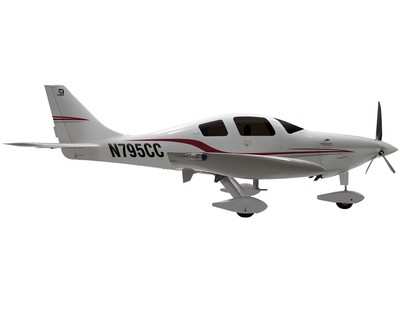Aircraft Impacted Water, Cockpit And Parts Of The Fuselage Were Not Recovered
The NTSB has released its preliminary report in an accident which fatally injured two people in North Carolina. The weather was reported as VFR at the time the Cessna Corvalis 350 departed from Davidson County Airport, but witnesses said they were unable to see the airplane shortly before it went down in High Rock Lake due to heavy fog. The parts of the airplane that were recovered showed signs of "severe fragmentation."

NTSB Identification: ERA12FA205
14 CFR Part 91: General Aviation
Accident occurred Friday, March 02, 2012 in Salisburry, NC
Aircraft: CESSNA AIRCRAFT CO LC42-550FG, registration: N167ZP
Injuries: 2 Fatal.
This is preliminary information, subject to change, and may contain errors. Any errors in this report will be corrected when the final report has been completed.
On March 2, 2012, about 1340 eastern standard time, a Cessna LC42-550FG, N167ZP, was substantially damaged following a collision with water at High Rock Lake, Salisbury, North Carolina. The certificated private pilot and passenger were fatally injured. The airplane was registered to and operated by the pilot under the provisions of 14 Code of Federal Regulations Part 91 as a personal flight. Instrument meteorological conditions prevailed and no flight plan was filed. The flight originated from Davison County Airport (EXX), Lexington, North Carolina, about 1310.
A lineman at EXX stated that he spoke to the pilot prior to departure and the pilot informed him that his destination was Florida. The lineman said that he mentioned the weather to the pilot, and the pilot responded that he was going to stay below 1,900 feet and that he should be “okay.” Shortly thereafter, the lineman went over to refuel another airplane and heard the pilot announce on the Unicom frequency that he was going to depart runway 24. The lineman watched the airplane liftoff approximately 2,000 feet down the runway and climb out normally. "The weather at the time was visual flight rules (VFR) with very light drops of rain." The lineman recalled looking at the AWOS monitor and it was reporting 1,800 foot ceilings and 10 miles visibility. There were no distress calls made by the pilot or calls that the airplane was returning.

According to preliminary information obtained from the Federal Aviation Administration, the pilot departed VFR and climbed to approximately 2,000 feet. The pilot was not in radio contact with air traffic control at the time of departure and no radio transmissions were recorded. The airplane was observed on radar for approximately 2 minutes, before descending to 1,800 feet. According to witnesses, they heard the airplane flying overhead but did not see it due to heavy fog. The witnesses reported that shortly thereafter, they heard a loud splash in the lake and as they turned towards the direction of the lake, they saw a large spray of water. They believed that it was the airplane that they had just heard and they called the local sheriff's department.
The accident site was located in a lake, about 9 nautical miles south of EXX. The wreckage exhibited severe fragmentation and was submerged in water that was estimated to be about 27 feet deep. Sections of the wreckage recovered included flight control surfaces and the empennage. Sections of both wings, fuselage, the main landing gear assembly, engine and instrument panel were also recovered. The cockpit and sections of the center fuselage around the center wing spar were not recovered.
 SpaceX to Launch Inversion RAY Reentry Vehicle in Fall
SpaceX to Launch Inversion RAY Reentry Vehicle in Fall Aero-News: Quote of the Day (04.23.24)
Aero-News: Quote of the Day (04.23.24) Aero-News: Quote of the Day (04.20.24)
Aero-News: Quote of the Day (04.20.24) ANN's Daily Aero-Linx (04.20.24)
ANN's Daily Aero-Linx (04.20.24) Aero-News: Quote of the Day (04.21.24)
Aero-News: Quote of the Day (04.21.24)




